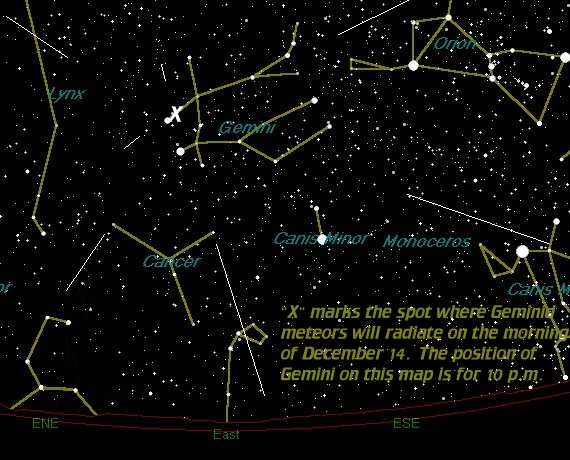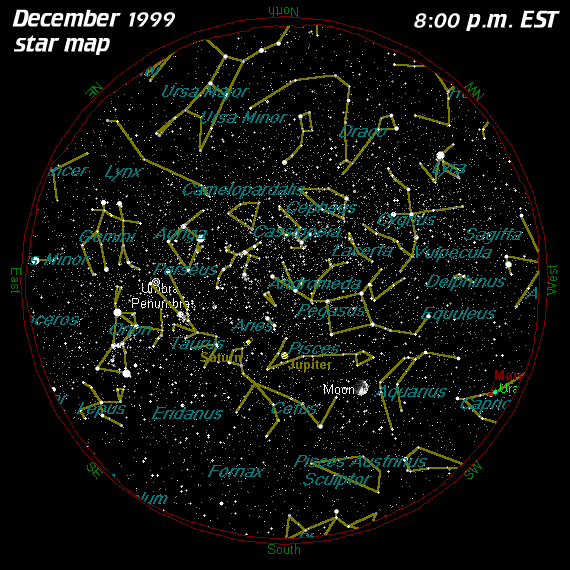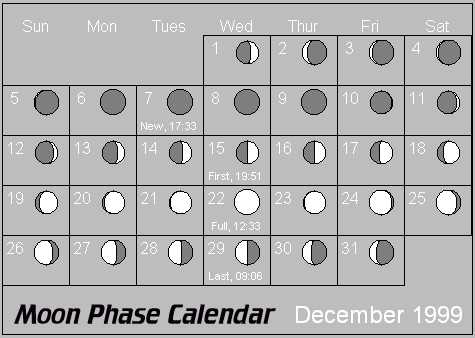

DECEMBER 1999
DECEMBER STAR MAP |
INDEX |
MOON PHASES
- 171
 DECEMBER 5, 1999: Photograph the Geminids
DECEMBER 5, 1999: Photograph the Geminids
- The morning of December 14 promises to be another exceptional opportunity to see many Geminid meteors. They will radiate near the star Castor of the Gemini Twins. The on-line map in the StarWatch section of the web site listed below positions the radiant. Geminids, on average, are about the brightness of the stars of the Big Dipper, and because hourly rates in rural settings could vary from between 50 to 150 meteors, an excellent opportunity exists to capture a Geminid on film. The equipment you will need is not that exotic. Granted, point-and-shoot cameras in most cases will not work, but you or a friend may have an old 35mm single lens reflex camera in storage somewhere. Youíll need a bulb setting on your shutter speeds, a cable release which can be locked, and a small tripod to keep your camera steady. A 50mm lens with a focal ratio of at least F/2.8, fast film between ASA 400-1000, and you are ready for some Geminid sleuthing. Point your camera in the direction of the radiant after 11 p.m. on the 13th. By this time the constellation will be high enough in the east so that light pollution will have less of an adverse effect on your pictures. I would suggest an exposure length of 5 minutes at F/2.0 with a film speed of 1000. Donít be afraid to use b/w films like Tri-X because light pollution will ruin the aesthetics of any color emulsion. However, I have had success with Kodak Royal Gold 1000 film which is a color emulsion. Royal Gold can be developed as a b/w negative to obtain the light sensitivity, without the unwanted color shifts due to light pollution. Stay away from slide films, wide-angle lenses, and telephoto lenses, unless youíre feeling especially lucky.
-
- 172
 DECEMBER 12, 1999: Star of Bethlehem: Part 1
DECEMBER 12, 1999: Star of Bethlehem: Part 1
- The Star of Bethlehem has long intrigued scholars. Did a real astronomical apparition occur which fulfilled the prophesy of the birth of a Messiah, and if so, when did it happen? Regardless of your beliefs, it is an interesting question. The Bible gives us an historical perspective--born under Roman rule in Bethlehem of Judea in the days of Herod, the King... born before Herodís death, but after a taxation decree of Augustus Caesar... a journey from Nazareth to Bethlehem to pay taxes... born before the journey of Wise Men (Zoroastrian priests) who saw His Star while in the East (Persia)... Herodís decree calling for the death of all males, two years or less... Historians feel that the taxation decree pertinent to this story occurred in 8 BC. It would have taken time, perhaps a year or more for the order to have filtered into Judea and time for Mary and Joseph to have prepared for their journey to Bethlehem. The earliest possible year for the Star seems to have been 7 BC. Herodís death was recorded by Josephus, a Jewish-Roman historian, as having occurred after a lunar eclipse and before the Jewish feast of the Passover. A partial lunar eclipse happened on March 13, 4 BC. On that year Passover occurred on April 12. Herodís death probably transpired around April 1, making 4 BC the latest possible time for the Star. However, Herodís edict to murder all male children two years or less after the Wise Men failed to disclose the Childís location to him, is additional evidence to push the date of the Star of Bethlehem back to 6 BC or 5 BC. Did an exciting astronomical event happen between 7 BC and 5 BC? Read ahead for the answer at the web address below.
-
- 173
 DECEMBER 19, 1999: Star of Bethlehem: Part 2
DECEMBER 19, 1999: Star of Bethlehem: Part 2
- What was the Star of Bethlehem? Planets, comets, supernovas, bright meteors, and auroras all could have been labeled as stars by ancient observers. Historians seem to feel that the "star" was seen between 7 BC and 5 BC (last weekís StarWatch). Astronomers seem to link a rare triple conjunction (coming together) of Jupiter and Saturn as an important consideration. It all started with faster moving Jupiter overtaking Saturn in the spring of 7 BC. By summer, Jupiter had stopped its eastward motion and moved backwards, or retrograded, to pass Saturn for a second time. Finally in the fall of 7 BC, Jupiter, moving eastward again, overtook Saturn for a third time. We see retrograde motion everyday. When a slower moving car is passed on a highway, the slower vehicle appears to move backwards with respect to the faster car. The retrograde motion of Jupiter (and Saturn) was the result of the faster moving Earth passing Jupiter and Saturn in Earthís yearly orbit around the sun. In early 6 BC, Mars joined the pair to form a loose grouping low in the west right after dark. The interpretation by the Wise Men of these events was even more interesting. The king of the gods (Jupiter) thrice passing the god which governed the destiny of the Jewish people (Saturn) in the constellation of Pisces, which to the Wise Men was the House of the Hebrews. Herod never saw the star the Zoroastrian prophesy foretold and which prompted the journey of the Wise Men, most probably in early 6 BC. The Jews were not interested in astrology. Whether the star was real or a myth depends upon personal beliefs; however, astronomers continue to do their part in unraveling an important mystery.
-
- 174
 DECEMBER 26, 1999: New Millennium Occurs in 2001
DECEMBER 26, 1999: New Millennium Occurs in 2001
- As we get ready to celebrate the New Year, be aware that it will not be the New Millennium. It is "just" the year 2000! We will have to wait another 366 days for the new millennium to be upon us. It all stems from the calculations of Dionysius Exiguus (Dennis, the little one), a Church scholar who lived in post-imperial Rome. He was charged with establishing a new calendric scheme based upon Christian values, excising the pagan traditions of the old Roman Empire. Appropriately, he chose the birth of Christ to begin his dating system, and used the well-established lineage of Roman emperors to retrace the number of years back to this occurrence. These calculations were made in AD 525. Dionysius reasoned that Christ had been born 524 years earlier. And there is the catch. According to Dionysius, Christ was NOT BORN IN THE YEAR ZERO, but rather in AD 1. There was no year zero. Thus began the hoopla over when decades, centuries, and millennia begin and end. The first decade was from AD 1, ending at the beginning of AD 11, the first century from AD 1 to AD 101, and the first millennium from AD 1 to AD 1001. The beginning of the year AD 11, AD 101, and AD 1001 was the beginning of the second decade, the second century, and the second millennium respectively. Carrying this convention forward into the twentieth century means that the third millennium cannot commence until January 1, 2001. So for all of you who have interest free payments until the new millennium, you technically still have a year to go. But before you start taking retailers to court, read the fine print of your contract. Happy New Year! Happy New Millennium, next year!
-








